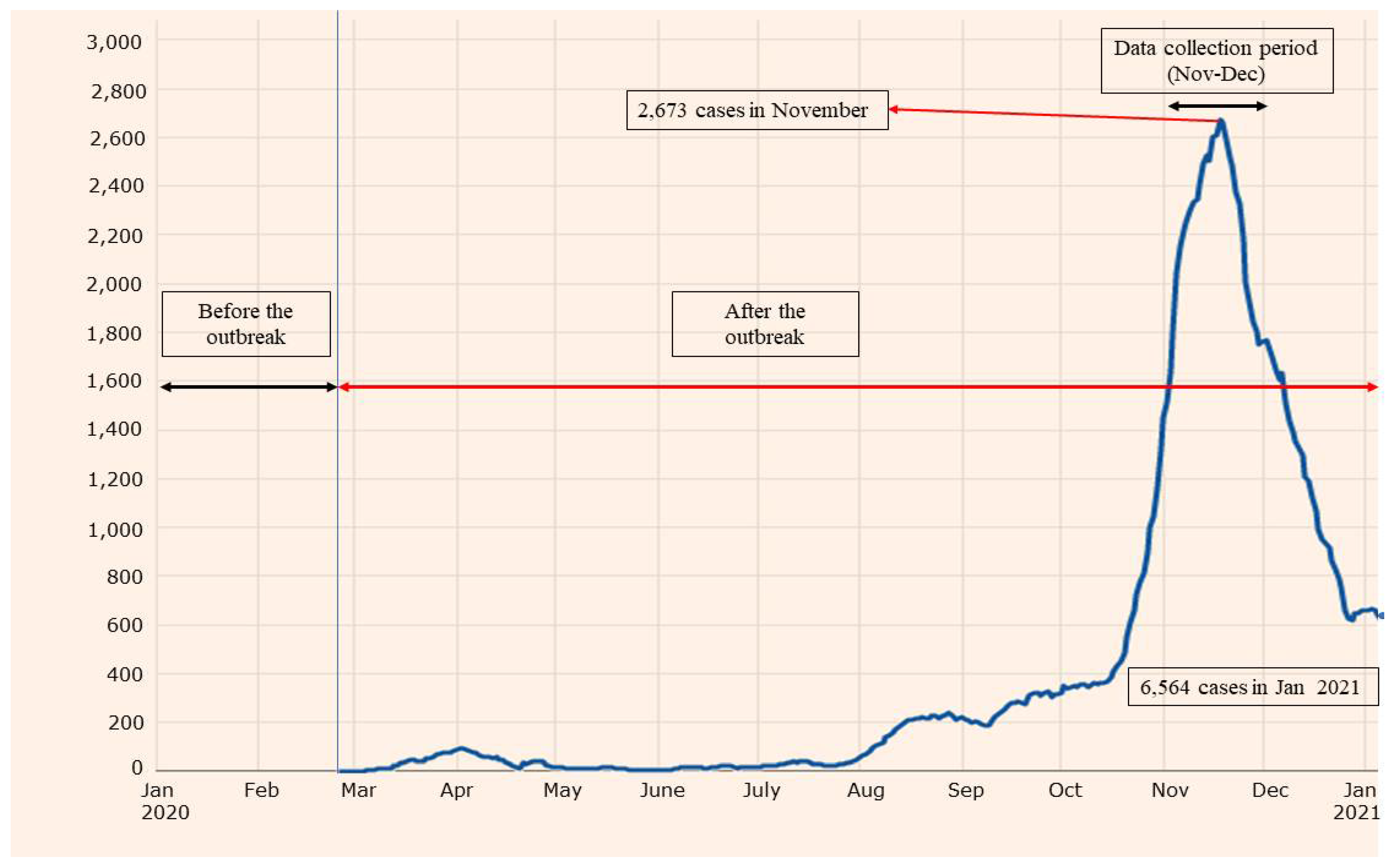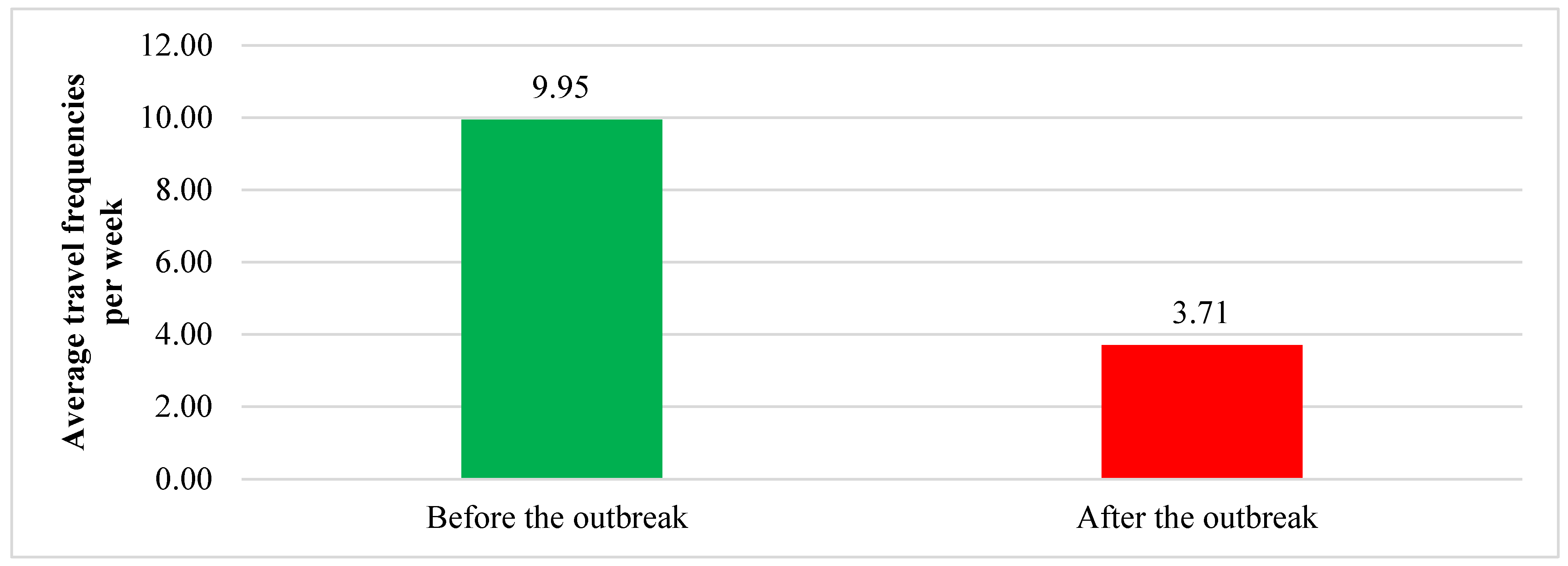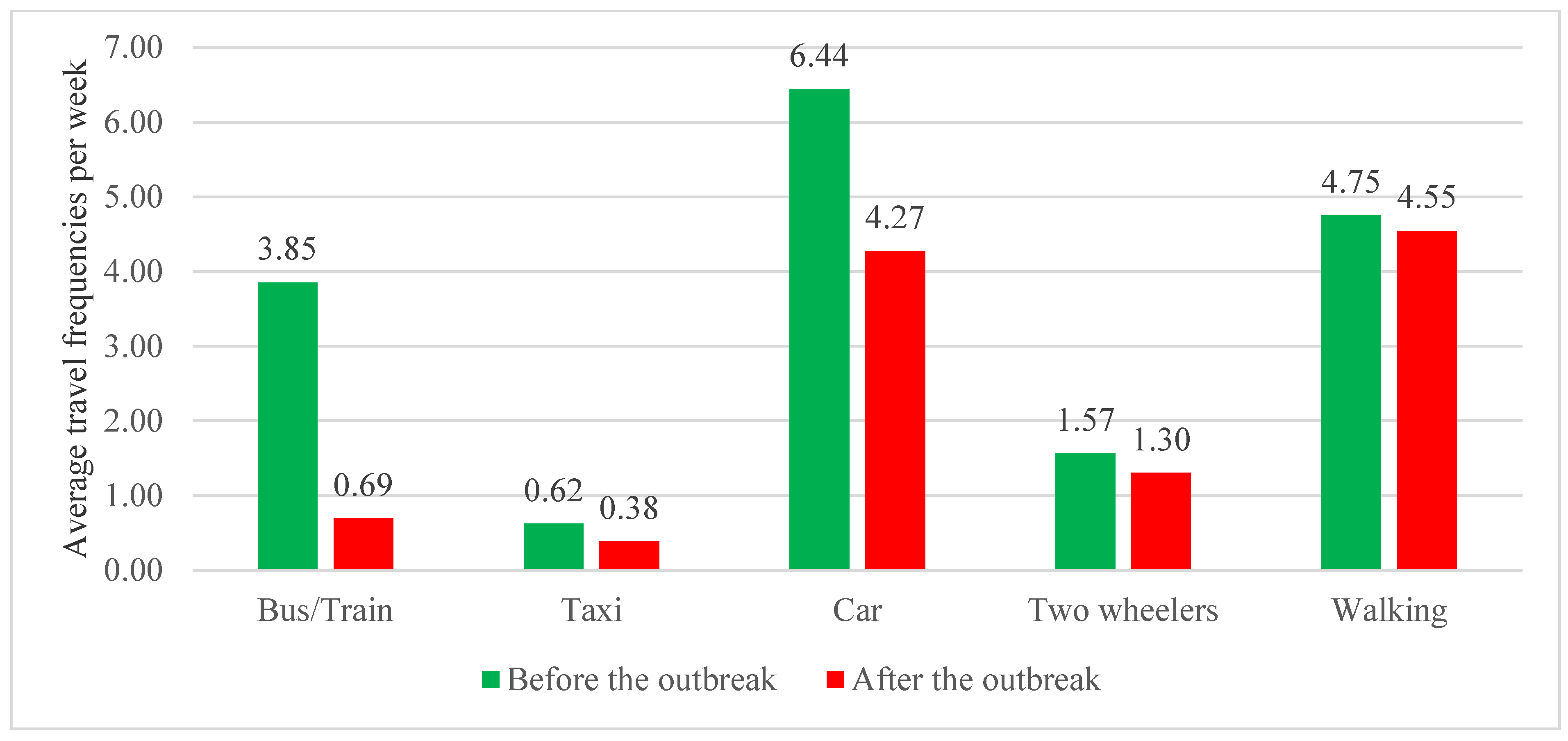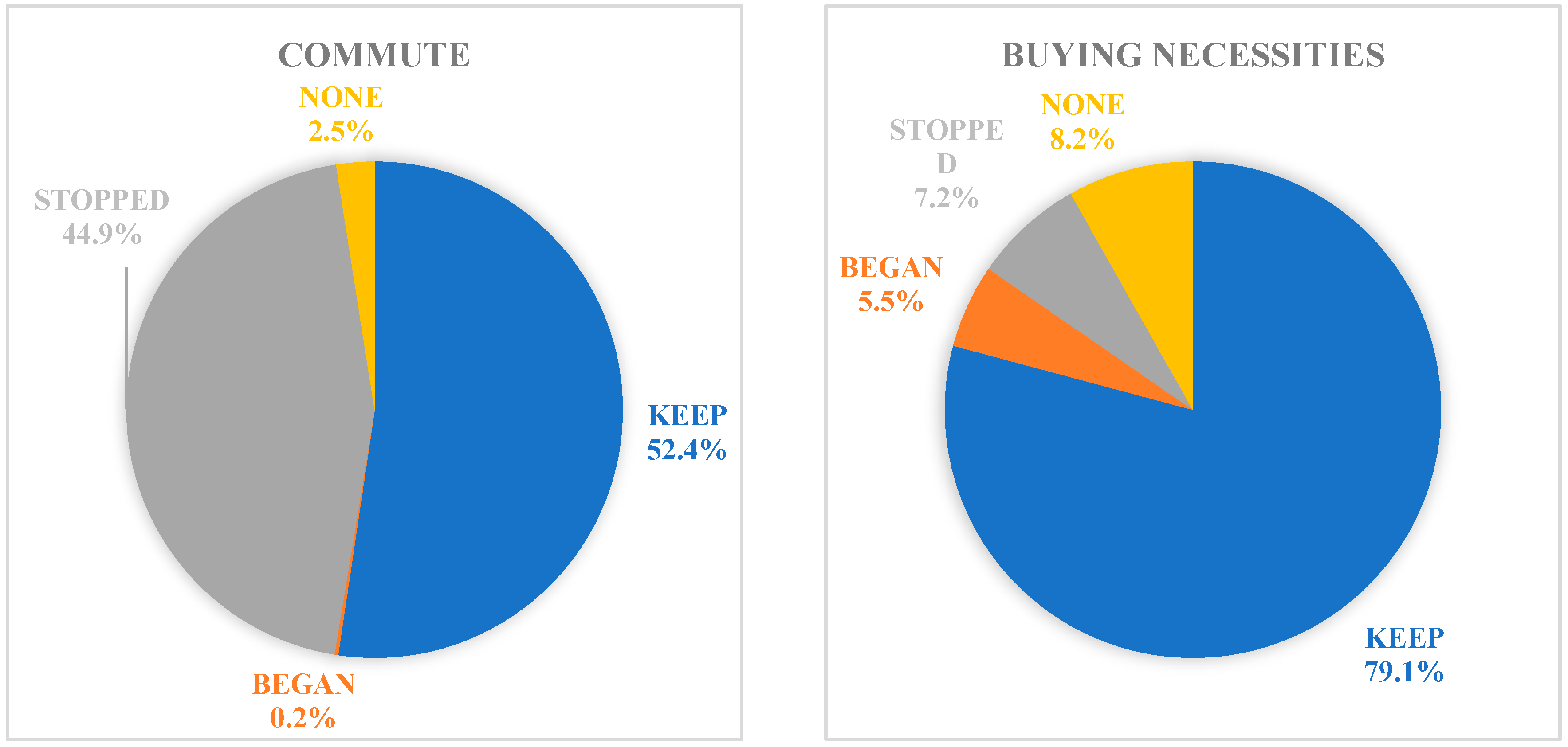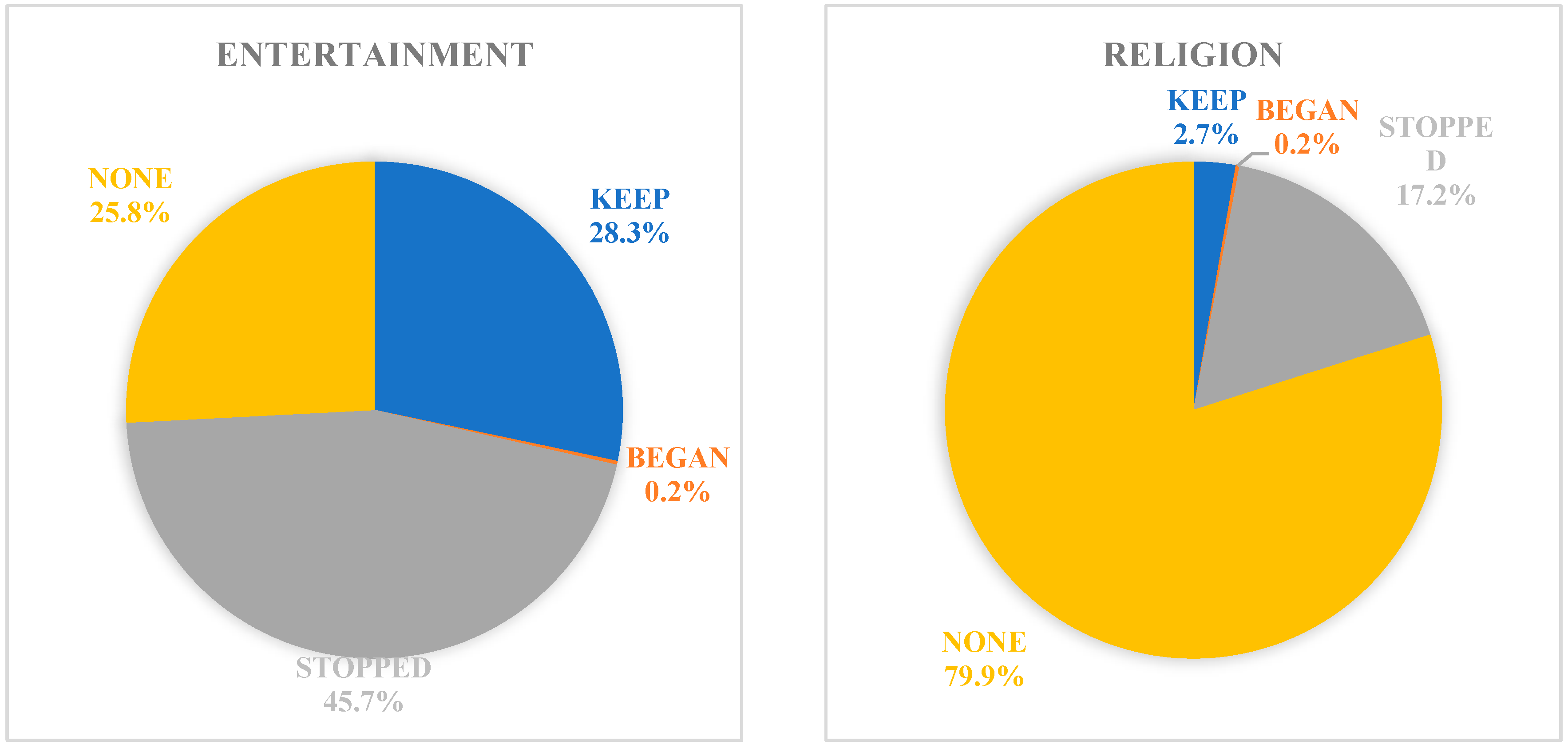1. Introduction
The World Health Organization declared COVID-19 (Coronavirus disease 2019) as a pandemic in March 2020 [
1]. COVID-19 has been adversely affecting all aspects of human societies [
2,
3] after its outbreak in late 2019. As of 27 July 2021, the number of COVID-19 confirmed cases had reached over 194 million, and nearly 4.16 million have died [
4]. To control the spread of COVID-19 in its early period, governments took a series of actions, including closure of non-essential businesses, self-isolation, and travel bans [
5,
6]. Traditional offline working shifted to online working and telecommuting [
7,
8]. Additionally, the COVID-19 pandemic situation has been largely affecting people’s travel behavior around the world [
9].
Recently, many studies around the globe, i.e., China [
10,
11], Italy [
12], Australia [
13], Sweden [
14], Spain [
15], the United States [
16], Pakistan [
9], Germany [
17,
18,
19], Greece [
20], Jordan [
21], and Turkey [
1], have been focusing on the variations in people’s mobility and travel behavior during COVID-19. Past studies pointed out that trip frequencies, travel duration, mode choice, commuting, and public transport usage worldwide have been receiving adverse effects of the COVID-19 pandemic [
22,
23]. A review of previous studies highlights that few modeling efforts have been conducted in the past to explore the relationship among mobility behaviors (travel trips by modes and by purposes), sociodemographic, and COVID-19 severity periods.
The mobility behavior changes mentioned in the previous studies were sensitive to the local context, including regional variations, socioeconomics, culture, and territorial boundaries. For example, shared bikes became popular mobility options for people living in Thessaloniki, Greece [
8]. In contrast, the average trip duration in New York, Chicago, and Boston has been increased together with reduction in bike trips due to COVID-19 [
24]. Likewise, the effects of socioeconomic characteristics, including gender, income, and age, on change in travel behavior were observed in Greece [
22].
Whilst there have been multiple studies conducted to explore the COVID-19 impacts on travel behavior, the studies using modeling attempt to explore the relationship of change in mobility behaviors (i.e., travel trip frequencies and travel purposes) with respect to the change in COVID-19 severity periods are limited especially in the Greek context. Furthermore, past studies relied on the data from the early stages of the COVID-19 outbreak, rather than the last months of 2020 when Greece faced the peak of COVID-19 confirmed cases and deaths. Furthermore, the current understanding of perceived COVID-19 threats on behavioral intentions towards public transport usage is also limited.
Thus, this study aims to fill this research gap and provide suggestions and references for relevant authorities regarding transportation management in pandemics. This study consists of three main objectives. First, to reveal the changes in the people’s mobility behavior in aspects of average weekly travel frequencies and trips by transportation modes and by purpose before and after the COVID-19 outbreak. Second, to quantify the influence of sociodemographic characteristics, public perceptions, and COVID-19 perceived fears on the changes in trip frequency by travel modes and travel purposes after the COVID-19 outbreak. Third, to measure the influence of the attitudes, subjective norms, and perceived COVID-19 threats on the behavioral intentions to use public transportation.
The current study differs from previous ones [
8,
20] that explored the COVID-19 impacts in Greece in some aspects. For example, this study uses the data collected in November and December of 2020 to explore the factors affecting the travel frequencies by modes and change in travel purposes after the outbreak together with the effects of the perceived threat from COVID-19 on the public intentions regarding public transportation usage. By adopting the random parameter probit modeling approach, this study extends the existing literature by exploring the heterogeneity across the self-reported responses. Besides, the structural equation modeling approach benefited this study by exploring the relationship among perceived COVID-19 threat, attitudes, subjective norms, and public transportation usage intentions. To sum up, this study provides a detailed picture of the mobility changes due to COVID-19 as it covers sociodemographic aspects, changes in travel frequencies and travel purposes, and public perceptions of safety threats of COVID-19.
In Greece, COVID-19 cases started to be confirmed in the last days of February 2020 [
20]. The increasing trend in the confirmed COVID-19 cases varied throughout the year, as presented in
Figure 1. After the outbreak, Greece implemented lockdown measures [
5], resulting in a slow increase in the number of confirmed COVID-19 cases in the first few months. The end of Greece’s first lockdown period ended in early May 2020, but a few months later, specifically in early November, the country was locked down all over again with strict measures. Even with tough restrictions in place, the confirmed COVID-19 cases dramatically increased in November and December 2020, as shown in
Figure 1.
For understanding, this study included two time periods, i.e., before the outbreak and after the outbreak, as shown in
Figure 1. As mentioned previously, Greece has experienced nationwide lockdowns. When the national lockdown was not active, there were still active restrictions carried out by the government. For most of the outbreak period, schools and universities were closed down, and teaching was mostly conducted online. Likewise, work from home was maintained at a high level but varied depending mainly on different companies’ policies. The government regularly emphasized social distancing, and face masks were kept mandatory only in indoor places and on transportation. The entertainment sector also saw restrictions, which kept entertainment-related places shut due to their indoor nature or large potential crowds.
Willingness to Use Public Transportation
COVID-19 has adversely affected the public transportation systems worldwide. As a result, public transportation’s ridership has continuously decreased and has received negative public perceptions [
25]. To this view, researchers and policymakers are interested in people’s intentions to use public transportation to develop marketing strategies and managerial applications to increase ridership [
26,
27]. The transportation policy-related soft measures, which include voluntary changes through psychological and behavioral strategies, play an essential role in motivating people to use public transportation by enhancing intentions to use public transportation [
28,
29]. Therefore, it is of great interest to explore the willingness to use public transportation in Greece to propose managerial implications for the transportation agencies supporting the increase in ridership in the post-pandemic world.
The behavioral theories that have remained prominent in transportation literature to explore people’s behavioral intentions and willingness, include the theory of reasoned action [
30], theory of planned behavior [
31], the social cognitive theory [
32], technology acceptance model [
33], and unified theory of acceptance and use of technology [
34]. For example, Alzahrani et al. [
35] applied the theory of reasoned action to explore the consumers’ intentions to use hybrid electric vehicles in Saudi Arabia. Baig et al. [
29] used the theory of planned behavior to identify the factors to promote pro-social behavior necessary for inclusive public transportation. The social cognitive theory has been applied to explore the media influence on the public acceptance of automated vehicles [
36]. The technology acceptance model and unified theory of acceptance and use of technology have been applied to explore the intentions to use electric vehicles [
37] and shared electric car-sharing systems [
37].
Past studies indicate that the applications of social and behavioral theories vary according to the context of the behavior and influential factors [
38]. The behavioral intentions to use public transportation in the post-pandemic period have not been sufficiently explored in the Greek context. Additionally, theory of reasoned action can be considered as the basic theory to explore behavioral intentions holding an explanatory power across various cultural contexts [
39]. Therefore, the present study applied the theory of reasoned action to explore the intentions to use public transportation in the post-pandemic period. According to the theory of reasoned action, attitudes and subjective norms influence people’s behavioral intentions. The attitude refers to unfavorableness or favorableness towards performing a behavior [
40]. Subjective norms indicate the perceived social pressure that others (parents, spouse, friends) desire the individual to perform or not perform a behavior [
41]. To capture the safety threats of COVID-19, perceived COVID-19 threats were also considered to predict the behavioral intentions to use public transportation following previous studies [
42,
43]. Perceived COVID-19 threats mean one’s feeling of fear from COVID-19, which is also a reason for people to avoid public transportation after pandemics [
43].
A hypothesis model was developed consisting of subjective norms, attitudes, perceived safety threats of COVID-19, and willingness to use public transportation. The hypothesis (H1) indicates that the attitudes are directly and positively related to the intentions to use public transportation, as indicated in
Figure 2. Hypothesis (H2) emphasizes that subjective norms directly affect the intentions to use public transportation. This study assumed that the attitude (H4), subjective norms (H5), and willingness to use public transportation (H3) were affected by the perceived COVID-19 threats, as shown in
Figure 2.
2. Methods
2.1. Questionnaire Design
A three-fold questionnaire was designed to collect the required data for this study. The first part included the participants’ trip frequencies by mode and travel purposes before and after the outbreak of COVID-19. Further details were asked regarding COVID-19 severity, the mode of transportation participants feel is safer, and the extent to which COVID-19 impacts flexible travel. The respondents were also asked to choose travel purposes, including commuting/school/university/picking up children, buying necessities, visiting hospitals, entertainment and visiting relatives and friends, and religious activities.
The second part was based on the hypothesis derived from the theory of reasoned action [
30], as shown in
Figure 2. A five-point Likert scale ranging from 1 = strongly disagree to 5 = strongly agree was used to rate the items to measure attitudes [
40], subjective norms [
41], and intentions to use public transport [
28] in the post-pandemic period, as shown in
Table 1. In line with a previous study [
43], a seven-point Likert scale ranging from (1 = not true at all) to (7 = true at all) was used to rate the items for the perceived COVID-19 threats.
The third part included the sociodemographic details of the respondents, including gender, age, education level, occupation, place of residence, place of occupation, the impact of COVID-19 on occupation status, and monthly family income.
2.2. Data Collection
Considering the COVID-19 pandemic situation, it was not possible to collect data by distributing paper-based questionnaires among respondents. Therefore, responses were procured through an online questionnaire survey using a convenience sampling procedure, consistent with previous studies [
44,
45]. The questionnaire was developed in Google Forms. The web link containing the questionnaire was distributed randomly on social media (mainly on Facebook) among Greeks. To confirm the location of the target audience, the respondents were asked to specify the location of their residence. The questionnaire was available online from the 27 November 2020 to the 11 December 2020. The data collection exercise resulted in the collection of 415 responses. After deleting the incomplete and invalid responses, 403 valid responses were used for the data analysis.
It should be noted that the majority of the data collected in this study refers to Attica, a region in Greece. The aim that the questionnaire survey was conducted focusing particularly on the region of Attica is twofold. At first, Attica is the metropolitan area of Greece where almost half of the country’s population resides, including Athens, which is the capital of Greece. Therefore, by targeting this highly densely populated area with a highly complex transportation system, the survey is able to provide us with valuable insights. Secondly, this region is the only one in Greece, where beyond private cars, all types of transport modes exist, namely underground and aboveground rail (and tram), an extensive network of bus lines, bicycle road sections, etc. Meanwhile, in this region, there are also various types of operations, i.e., public workers, small and big businesses, major universities, etc. As a result, it is the appropriate place to explore the impact of the pandemic on people’s mobility behavior. Besides, such regions are commonly found in many European metropolitan cities, and because of that, this study can be useful since its results can be compared with others of similar cases. As far as the sampling process is concerned, the convenience sampling procedures for the respondents’ inclusion in an online questionnaire survey may have sampling bias. However, convenience sampling was found acceptable by recent studies given the pandemic situation and urgency to collect data exploring mobility behaviors [
44,
45]. This research was exploratory in nature, and in this sense, a representative sample was not of utmost importance. In this case, this study tried to go for volume and area coverage, thus the questionnaire was open to the public by posting it on social media, and at the same time, we targeted specific individuals to cover different areas of Attica. Both the final sample size and its distribution in the whole region helped in drawing the initial conclusions. The valuable results drawn from this study can trigger future research endeavors focusing on examining the mobility behavior of specific groups.
2.3. Analytical Method
Following the aim of the study, three analytical approaches were used to achieve the objectives of the study. First, the reduction in people’s travel trips and the change in travel purposes after the outbreak were presented using descriptive analysis. Second, the random parameter probit model approach was adopted to explore the relationship between participants’ sociodemographic features, perceptions of COVID-19 impacts, and mobility behavior changes after the outbreak. Third, the structural equation modeling approach was used to provide insights regarding the effects of attitudes, subjective norms, and perceived COVID-19 threats on willingness to use public transportation in the post-pandemic period.
2.3.1. Descriptive Analysis for Objective 1
The self-reported travel frequencies and the distribution of frequencies by travel modes and by travel purpose before and after the COVID-19 outbreak were compared through graphical representation.
2.3.2. Random Parameter for Objective 2
The random-parameter probit model allows parameters to vary across observations to capture the unobserved heterogeneity. As this study included the data collected through a questionnaire survey, responses were expected to have some unobserved correlations among error terms as the same respondent responded for multiple questions. For the random parameter probit model of travel frequencies, change in the trip frequencies (b) before the outbreak to (a) after the outbreak and coded as: b−a > 0 → 1 (decrease in trips), 0 → (no decrease in trips) was taken as a dependent variable. For the random parameter probit model of travel purposes, the dependent variable was the change in travel purpose (b) before the outbreak to (a) after the break and coded as: b−a > 0 → 1 (change in travel purpose), 0 → (no change).
A mathematical expression of the binary outcome of the model [
46,
47,
48] can be expressed as:
with the cross-equation correlated error terms,
where
X is the explanatory variable determining the change in trips, including an increase or decrease after the COVID-19 outbreak or change in travel purposes based on characteristics of observation ί,
y resembles an integer binary outcome of zero or one for both dependent variables,
β is estimable parameters,
ε is a random error that is assumed to be normally distributed with zero mean and a variance of one.
The unobserved heterogeneity with each group of observations generated by participants can be defined as follows:
where
β is estimable parameters and
is a randomly distributed term for each respondent
j with variance
and mean zero. For the adopted modeling approach, each
β is defined for each respondent
j, contrasting to the traditional random parameter modeling with each
β is calculated for each observation
i. In other words, Equation (3) demonstrates that each participant will have their own value of
β. This study assumes that the random parameters are normally distributed, with the mean and standard deviations calculated and presented in the modeling results section.
2.3.3. Structural Equation Modeling for Objective 3
The effects of the perceived threat from COVID-19 on the behavioral intentions to use public transportation in the post-pandemic world were analyzed using structural equation modeling (SEM). A partial least square path modeling (PLSPM) approach of SEM was employed to capture the relationship among variables (latent constructs), consistent with previous studies [
36,
49,
50]. It includes two models, i.e., the measurement model and the structural model. The measurement model can be written mathematically as [
51]:
where
represents the vector values of latent variables,
B refers to the coefficients’ matrix of their relationships, and
indicates the residuals of the inner model. The basic PLSPM design assumes a recursive inner model that is subject to predictor specification. For this study, each manifest variable in a certain structural model is assumed to be generated as a linear function of its latent variables and the residual ε:
where
Λ represents the loading (pattern) coefficients. We used a package called “plspm” in R software to conduct structural equation modeling through the PLSPM [
49].
4. Discussion and Implications
Through the descriptive analysis method, total traveling frequencies appeared to be down by more than 50% (
Figure 3), signaling adverse impacts of the COVID-19 outbreak on people’s mobility behavior. All modes were found to have taken a hit except two-wheelers and walking, which appeared only to have minor reductions (
Figure 4). A plausible reason for the significant reduction in bus/train usage is the decrease in the need to travel and the fear of catching COVID-19 in the compact spaces that public transport provides. On the contrary, walking was found to be preferred as a contact-free mode of traveling by people. This shift towards active transportation can prevent individuals from shifting back towards motorized transportation through supportive measures, management, and organizational support.
A huge percentage of people were found to have stopped commute trips, possibly due to the switch to remote working and online teaching, respectively. Similarly, entertainment trips were also reduced because social gathering places, including bars and cinemas, remained closed. On the other hand, trips for buying necessities appeared to have no dramatic change as they essentially cannot drop significantly due to their vital role in everyday life.
A comparison with similar research studies is important for the best possible understanding of the results. Unfortunately, there are no studies available researching the same post-outbreak period, but there are plenty in the city of Thessaloniki in Greece during the first lockdown period. Based on data, Politis, Georgiadis, Papadopoulos, et al. (2021) found a 50% reduction in total daily travel trips and a huge decline in public transportation ridership, as well as a rise in walking as a mode of travel. Furthermore, total car usage was found to be similar to the pre-pandemic period. Their results are in agreement with the ones from this current study. In addition, Politis, Georgiadis, Papadopoulos, et al. (2021) found that the percentage of public transportation use in total trips approached zero. It should be noted that the public transportation network in Thessaloniki is limited to mostly buses, thus making this finding seem logical. On the other hand, this study showed a reduced ridership of buses/trains. In contrast with this research, age was found to similarly affect travel frequency after the pre-pandemic and the pandemic period.
By shedding light on the dynamics of people’s travel behaviors and public perceptions of COVID-19, this study offers insightful findings for transportation planning and policy development. The reduction in commuters’ trips indicates the potential of working from home after the COVID-19 outbreak. Nevertheless, the telecommuting rates during the pandemic differ by sociodemographic features and job type [
56]. Thus, findings suggest policymakers consider promoting telecommuting in the post-pandemic as it has the potential for a sustainable future by reducing traffic congestion and improving air quality [
16].
The variations were found in sociodemographic features and perceived perceptions based on travel modes and travel purposes affecting travel frequency change. It indicates that the policymakers need to explicitly consider travel modes and travel purposes for traffic management in pandemics. The random parameter approach highlighted the individual’s heterogeneity to reduce travel frequencies and change in travel purposes. The insightful results explaining the significant factors and individuals’ heterogeneity indicate that sociodemographic oriented and local areas-based preventive measures will be more effective for travel behavior management after the COVID-19 outbreak.
A new opportunity for active transportation has been observed in this study’s findings. Meanwhile, road pricing policies should be revisited, considering the new trends in the distribution of travel modes. Transport policies to promote active transportation should be formulated to sustain mobility by walking. Perceptions of COVID-19 significantly affected the change in total trips indicating the need to boost the dissemination of information about COVID-19 to the general public. The perceived safety threats of the spread of COVID-19 due to traveling in public and shared transportation can be reduced by implementing hygienic measures, sanitizations of vehicles, and standard temperature checks for drivers and passengers. The rewarding strategies can be introduced for the responsible behaviors of wearing masks while traveling on public transportation leading to a decrease in the perceived safety threats of being infected by COVID-19 while traveling on public transportation. The dynamic reward system will be more effective considering the heterogeneity of responses found in this study.
Finally, the findings indicated that the COVID-19 threat negatively impacted both attitude and subjective norms towards the willingness to use public transportation. It was also found that both attitude and subjective norms are still positive towards public transportation usage. Taking it all into account, even though it was found that the COVID-19 threat did not have a direct relationship with willingness to use public transportation, it impacted it through attitude and subjective norms. The reduction in public transportation usage will result in a decline in revenue in the long run, causing massive economic losses. Such economic losses may posit compromise in service quality affecting public transportation adversely. Rethinking fare structures considering off and peak hours will become necessary after COVID-19 [
57]. Transportation authorities should formulate some strategies to cope with a post-pandemic situation. Providing incentives to lower-income groups who use public transportation [
57], shaping inclusiveness for people with disabilities [
29], and starting awareness campaigns will help bring the riders back to public transportation in the post-pandemic world. More research is needed to find alternate ways to manage the increased cost of public transportation due to COVID-19 preventive measures, as highlighted in a previous study [
15]. Recent studies [
58,
59] on policy development can be followed to derive policy measures from the present study’s findings.
5. Conclusions, Limitations, and Future Works
By shedding light on the change in mobility behavior in Greece before and after COVID-19, this study provides useful information regarding the relationship of individuals’ sociodemographic factors, change in mobility behavior, and public perceptions of COVID-19. The study’s findings are helpful for transportation planners and policymakers interested in the variations in travel trips and the preparation of traffic management plans. This study confirms that COVID-19 affected individuals’ travel in Greece. Transportation organizations should consider collecting and incorporating people’s mobility data for the planning of a resilient transportation system to prevent future health threats. In a post-pandemic world, people are less willing to use public transportation as they perceive COVID-19 as a threat. Transportation authorities should organize sufficient efforts to attract citizens back to public transportation. The implementation of the preventive strategies of COVID-19, including the cleaning and disinfecting of public buses, availability of sanitizers, and ensuring the wearing of masks by passengers, will be helpful in reducing perceived COVID-19 threats by the public. Findings suggest that individuals’ sociodemographic features and perceptions about COVID-19 have a relation with the behavioral change after the outbreak. Thus, inclusive transportation planning should incorporate such information in policy preparation. Further research should be conducted to expand the current study and to find more avenues to minimize the worsening effects of pandemics on individuals’ mobility.
The findings of the study must be interpreted in light of certain limitations. This study relied on the self-reported data collected through convenience sampling due to COVID-19 standard operating procedures mainly reflecting the respondents’ personal opinions, which should be expanded by collecting a large population sample through random sampling. This study used the theory of reasoned action to explore willingness to use public transportation and highlighted the basic theoretical model explaining the effects of perceived COVID-19 safety threats. Future studies are recommended to consider the addition of further variables affecting intentions to use public transportation, such as willingness to pay for hygienic services, perceived behavioral control, self-efficacy, service quality, passengers’ behaviors (wearing masks), and service frequency. Further studies can replicate the methodology to extend the current findings in Greece and other countries’ contexts. More understanding of travel behavior is required to develop effective mitigating strategies in fighting against the COVID-19 pandemic.
